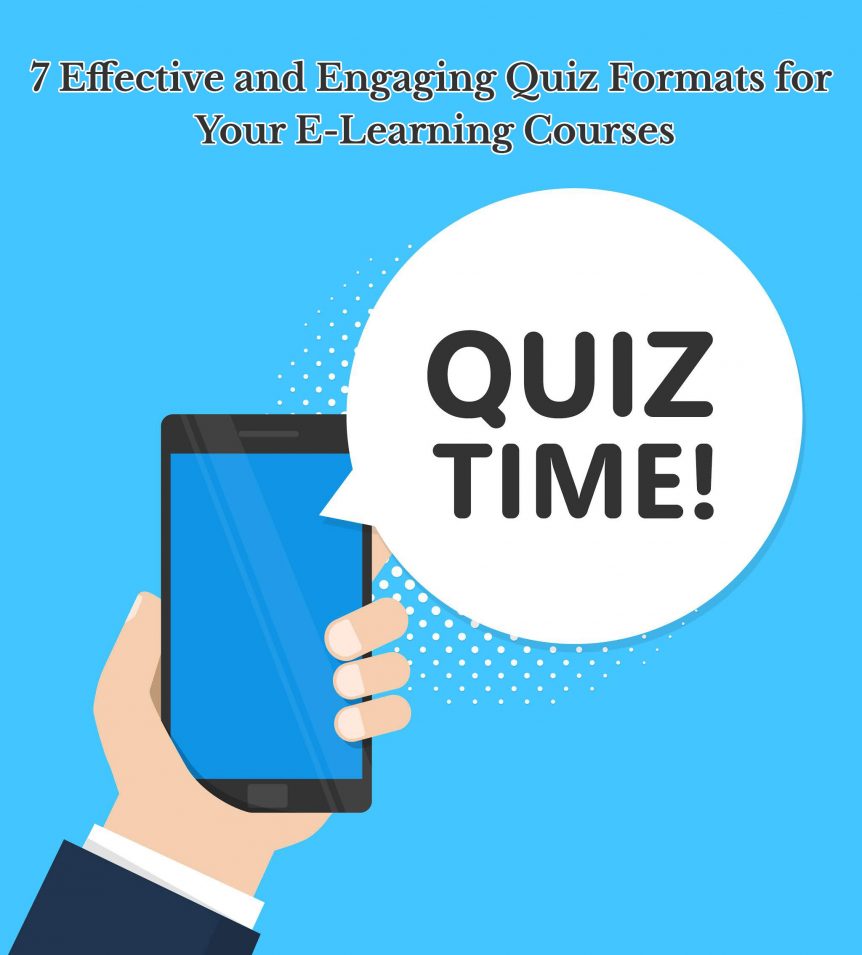7 Effective and Engaging Quiz Formats for Your E-Learning Courses
It’s common to see e-learning courses that have engaging, interesting, and interactive content but boring quizzes. This is a shame as quizzes are important parts of e-learning courses. They help with the learning process, refreshing the memory of learners and reinforcing the content. Quizzes also help you evaluate the progress of learners as well as the success of the course.
There is so much more you can do with quizzes than simply presenting learners with several multiple-choice questions. The following seven types of quiz format will make your e-learning courses engaging and interactive to the end.
1. Multiple Choice Questions
Okay, we’ve started with the most common type of quiz format, but it is effective, so does have a place. That said, you should consider incorporating some of the other formats below, mixing up the types of question you present to learners.
You can even go further by changing up the design and presentation of your multiple-choice quizzes. For example, you can base the quiz on well-known game and game show formats like:
- Spin the Wheel – where you have categories on a wheel that the learner spins. The learner must then answer a multiple-choice question based on the category selected by the wheel.
- Who Wants to be a Millionaire – add an element of competition to your e-learning quizzes by using a format based on Who Wants to be a Millionaire. This format involves multiple choice questions which get progressively harder.
- Trivial Pursuit – where learners must correctly answer a question in each category to win. You can even add an element of competition to this format.
By being creative with the design of your multiple-choice quiz, you will make it more fun and engaging without detracting from its effectiveness as a learning and evaluation tool.
2. Closed Questions
Closed questions give the learner a choice between two possible answers. The most common forms of closed question are:
- Yes/No
- True/False
Closed questions are often overlooked because of a fear they are too easy and/or guessable. They can be effective, however, particularly if you get creative with the design of your quiz.
For example, you can format the quiz as a maze where the answers to closed questions determine the learner’s route through the maze. Only by getting the questions correct will the learner successfully get to the centre of the maze.
3. Open Questions
Open questions are questions where the learner must write out an answer, either as a sentence or a paragraph. It is usually best to use them sparingly, although they can really help you understand whether or not the learner has fully grasped the topic.
After all, you can guess a closed question. You can even guess a multiple-choice question. It’s much harder to guess an open question, however.
4. Fill in the Blanks
Fill in the blank questions involve having a sentence or passage of text with words or phrases missing. There are multiple ways you can get the learner to fill these blank spaces:
- Type in the answer
- Drag and drop from pre-selected words
- Answer the question using tick boxes
As with many of the other options on this list, being creative with the design of fill in the blank quizzes will increase learner engagement and interactivity.
5. Labelling/Definitions
Labelling or definition questions involve presenting an image or a description to the learner which they then have to answer correctly. In other words, it is a “what is this” question.
To make them more interactive and engaging, you could design this quiz format as a crossword. After all, crosswords use definition questions where a one-word answer to each clue helps you finish it.
Another effective way of using labelling/definition questions is in product training. For example, showing learners parts or elements of a product and asking them to name those parts to demonstrate they understand the terminology, features, or brand names.
6. Matching the Pair
Matching pairs is another quiz format that you can creatively design to increase levels of engagement. Usually, this format involves having two lists of words or groups of objects. Each item on one list matches an item on the other. The learner has to find the pair.
7. Sequencing and Sorting Questions
With sequencing questions, you ask learners to put the options in the right order. This could be, for example, deciding on priorities in a certain situation, or the steps involved in successfully completing a task. Another example is categorising activities based on the level of health and safety risk.
Sorting questions involve getting learners to identify the right options from a larger group. Using health and safety as an example again, you could ask learners to choose all the personal protective equipment they would need to wear, according to health and safety procedures, to safely complete a specific task.
It’s All About Being Creative
Whatever quiz format you use, the key is to make the quiz more interactive and interesting than simply answering questions. Using creative designs, the style of the quiz, or the way you present the questions, can all achieve this. Quizzes that are creative will properly finish your course and keep learners engaged until the very end.
